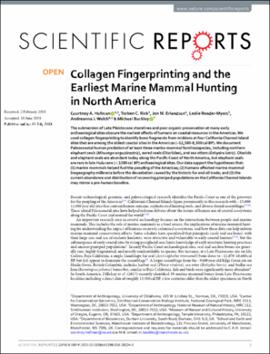| dc.contributor.author | Hofman, Courtney A. | |
| dc.contributor.author | Rick, Torben C. | |
| dc.contributor.author | Erlandson, Jon M. | |
| dc.contributor.author | Reeder-Myers, Leslie | |
| dc.contributor.author | Welch, Andreanna J. | |
| dc.contributor.author | Buckley, Michael | |
| dc.date.accessioned | 2018-11-29T18:45:13Z | |
| dc.date.available | 2018-11-29T18:45:13Z | |
| dc.date.issued | 2018-07-03 | |
| dc.identifier.citation | Hofman, C. A., Rick, T. C., Erlandson, J. M., Reeder-Myers, L., Welch, A. J., & Buckley, M. (2018). Collagen Fingerprinting and the Earliest Marine Mammal Hunting in North America. Scientific reports, 8(1), 10014. | en_US |
| dc.identifier.uri | https://hdl.handle.net/11244/316228 | |
| dc.description.abstract | The submersion of Late Pleistocene shorelines and poor organic preservation at many early archaeological sites obscure the earliest effects of humans on coastal resources in the Americas. We used collagen fingerprinting to identify bone fragments from middens at four California Channel Island sites that are among the oldest coastal sites in the Americas (~12,500-8,500 cal BP). We document Paleocoastal human predation of at least three marine mammal families/species, including northern elephant seals (Mirounga angustirostris), eared seals (Otariidae), and sea otters (Enhydra lutris). Otariids and elephant seals are abundant today along the Pacific Coast of North America, but elephant seals are rare in late Holocene (<1500 cal BP) archaeological sites. Our data support the hypotheses that: (1) marine mammals helped fuel the peopling of the Americas; (2) humans affected marine mammal biogeography millennia before the devastation caused by the historic fur and oil trade; and (3) the current abundance and distribution of recovering pinniped populations on the California Channel Islands may mirror a pre-human baseline. | en_US |
| dc.language | en_US | en_US |
| dc.rights | Attribution 4.0 International | * |
| dc.rights.uri | https://creativecommons.org/licenses/by/4.0/ | * |
| dc.subject | Biology, Conservation | en_US |
| dc.subject | Biology, Marine | en_US |
| dc.subject | Palaeoecology | en_US |
| dc.title | Collagen Fingerprinting and the Earliest Marine Mammal Hunting in North America | en_US |
| dc.type | Article | en_US |
| dc.description.peerreview | Yes | en_US |
| dc.identifier.doi | 10.1038/s41598-018-28224-0 | en_US |
| ou.group | College of Arts and Sciences::Department of Anthropology | en_US |

